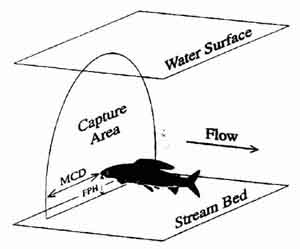Fish bioenergetics includes components
of physical forces, thermodynamics, and light characteristics, and follows
energy laws and theories describing any other closed system. What it all
boils down to is the net rate of energy intake. If this rate is positive
a fish will grow and if it is negative then a fish will begin to undergo
the stresses of losing biomass.
Fish bioenergetics is really a matter of efficiency.
Potential profit for a fish at any given position in a stream is simply
the amount of energy coming into its system as prey minus the cost of staying
at that position. This simplified model can be desribed by
P = D - S
where P is potential profit (calories/hour), D is available drifting invertebrate
energy (calories/hr), and S is swimming cost (calories per hour) (Fausch
1984). For example, the fish in the diagram below has a particular capture
area as it faces upstream, and available (potential) energy depends on
the quantity and quality of prey items that float downstream through that
area. Energy expended by the fish depends on the velocity (flow) of the
water and the swimming capability of the fish. The fish must exert a force
in the upstream direction that is equal to the force of the water trying
to push it downstream. When the fish goes to retrieve a prey item laterally,
it will have to swim faster than the current.
Getting a little bit more
complex, we can consider Holling's disc equation (Stephens and Krebs 1986)
which can apply to any foraging animal. This equation's most simplified derivation
is
R = λe - s/ 1 + λh
where R is the rate of intake, λ is the rate of encounter
with other prey items, e is the energy gain, s is the search cost, and h
is the handling time. This equation assumes that searching for prey and handling
prey are mutually exclusive activities. It also assumes that the encounter
rate will have a positive linear relationship with the time spent searching
for prey. For fish, many aspects of the physical environment can effect
all of these components.
